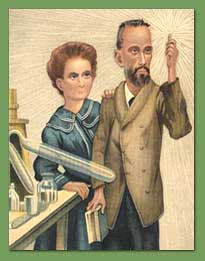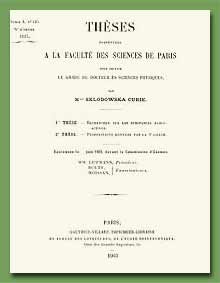|

 Honors from Abroad
Honors from Abroad
 RANCE
WAS LESS FORTHCOMING than other countries when it came to honoring
the Curies' work. In early June 1903 both Curies were invited to
London as guests of the prestigious Royal Institution. Since custom
ruled out women lecturers, Pierre alone described their work in
his “Friday Evening Discourse.” He was careful, however,
to describe Marie's crucial role in their collaboration. The audience
included representatives of England's social elite and such major
scientists as Lord Kelvin. Kelvin showed his respect by sitting
next to Marie at the lecture and by hosting a luncheon in Pierre's
honor the following day. RANCE
WAS LESS FORTHCOMING than other countries when it came to honoring
the Curies' work. In early June 1903 both Curies were invited to
London as guests of the prestigious Royal Institution. Since custom
ruled out women lecturers, Pierre alone described their work in
his “Friday Evening Discourse.” He was careful, however,
to describe Marie's crucial role in their collaboration. The audience
included representatives of England's social elite and such major
scientists as Lord Kelvin. Kelvin showed his respect by sitting
next to Marie at the lecture and by hosting a luncheon in Pierre's
honor the following day.
|
 |
| Britain's Lord Kelvin, whose contributions
in several fields helped shape the scientific thought of his
era, openly displayed his admiration for Pierre's scientific
achievements. |
|
 |
| The attention that English
scientists paid to the Curies' work helped make them household
names in that country, as in this famous caricature, “Radium,”
from the popular British periodical Vanity Fair. |
|
But all was not well
that weekend. Pierre was in such bad health that he had experienced
difficulty in dressing himself before the talk. His fingers were
so covered with sores that he spilled some radium in the hall while
demonstrating its properties. Ill health, however, kept neither
Curie from noting the value of the jewels worn by the members of
English high society they met in the course of the weekend. They
amused themselves by estimating the number of fine laboratories
they could set up with the proceeds from selling those jewels.
 ISITORS
FROM ABROAD also helped honor Marie on the occasion of her formal
thesis defense in June 1903. Her sister Bronya made the difficult
trip from Poland to celebrate Marie's academic triumph. ISITORS
FROM ABROAD also helped honor Marie on the occasion of her formal
thesis defense in June 1903. Her sister Bronya made the difficult
trip from Poland to celebrate Marie's academic triumph.
Bronya had insisted that the first woman to receive a doctorate in
France should acknowledge the special event by wearing a new dress.
Characteristically, Marie chose a black dress. Like the navy wedding
outfit she had chosen eight years earlier, the new dress could be
worn in the lab without fear of stains. |
 |
| Title page of the published version of Marie
Curie's doctoral thesis, “Research on Radioactive Substances.”
The examiners exclaimed that Curie's doctoral research contributed
more to scientific knowledge than any previous thesis project. |
|
Another foreign admirer
was a last-minute guest at a dinner to celebrate Marie's achievement.
New Zealand-born scientist Ernest Rutherford, who was also actively
engaged in research in the new science of radioactivity, was visiting
Paris. He had stopped by the Municipal School shed where Marie isolated
radium, and at dinner that night he asked Marie how they managed
to work in such a place. “You know,” he said, “it
must be dreadful not to have a laboratory to play around in.”
 AMILY
LOSSES UNDERCUT some of the pleasure Marie could take in her
own achievements. In August 1903 she experienced a miscarriage.
Some time later Bronya's second child died of tubercular meningitis.
And against the backdrop of these specific losses was the fact that
Pierre's health continued to deteriorate. Sometimes unbearable pain
kept him awake all night, lying weakly in bed, moaning. AMILY
LOSSES UNDERCUT some of the pleasure Marie could take in her
own achievements. In August 1903 she experienced a miscarriage.
Some time later Bronya's second child died of tubercular meningitis.
And against the backdrop of these specific losses was the fact that
Pierre's health continued to deteriorate. Sometimes unbearable pain
kept him awake all night, lying weakly in bed, moaning.
|
“I
had grown so accustomed to the idea of the child that I am absolutely
desperate and cannot be consoled.”
--letter from Marie Curie to Bronya, August 25, 1903
|
|
|
| Marie Curie in 1903, the
year her thesis was published. (Photo ACJC) |
|
|
� 2000 -
American Institute of Physics
|
|

